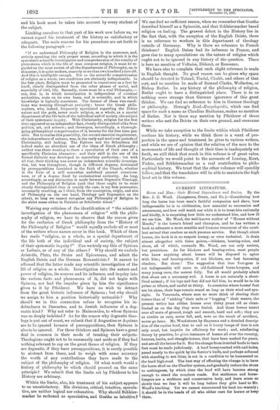CURRENT LITERATURE.
Horse and Man : their Mutual Dependence and Duties. By the Rev. J. G. Wood. (Longmans, Green, and Co.)—Considering how long the horse has been man's faithful companion and slave, how indispensable he is to civilisation, how essential to recreation and amusement, and how well worth our while it is to treat him rationally and kindly, it is surprising how little we understand him, and how ill we use him. Mr. Wood, the well-known author of " Homes without Hands," is the horse's friend and champion, and he has written a book to advocate a more sensible and humane treatment of the excel- lent animal that renders us such yeoman service. But though about horses, the book is in no respect horsey, or even technical. It deals almost altogether with three points,—blinkers, bearing-reins, and shoes, all of which, contends Mr. Wood, are not only useless, but pernicious. As for blinkers and bearing-reins, most people who know anything about horses will be disposed to agree with him ; and bearing-reins, if not blinkers, are fast becoming obsolete. Bat shoes ! The suggestion that iron foot-gear is not indispensable will seem to old-fashioned horse-keepers, and many young ones, the merest folly. Yet all would probably admit that shoes are a necessary evil. A horse is not naturally a short- lived animal ; if his legs and feet did not fail him, he would be in his prime at fifteen, and useful at thirty. In countries where horses' feet are let alone, their legs remain sound as long as their wind and eye- sight. In Venezuela, where men no more think of shoeing their horses than of " nicking" their tails or " hogging " their manes, the present writer has ridden horses over thirty years old as clean- limbed as on the day they were foaled. And these horses travel over all sorts of ground, rough and smooth, hard and soft ; they are as nimble as cats, never fall, and, save as the result of accident, never go lame. Mr. Wood shows by diagrams and a detailed descrip- tion of the equine hoof, that to nail on it heavy lumps of iron is not only creel, but impairs its efficiency for work ; and, reinforcing theory by practice, he gives instances of horses all over the country, hunters, hacks, and draught-horses, that have been unshod for years, and are all the better for it. But the change from ironclad hoofs to bare feet must be made judiciously. A hoof honeycombed with nail-holes, pared nearly to the quick by the farrier's knife, and perhaps softened with standing in wet litter, is not in a condition to be hammered on the hard high-road. The best way of effecting the change is to have the horse shod on the Charlier system, and gradually reduce the shoes to nothingness, by which time the hoof will have become strong enough to stand the roughest roads. But stablemen and horse- keepers are a stubborn and conservative body, and learn sense so slowly that we fear it will be long before they giie heed to Mr. Wood's teaching. Yet we cannot recommend his book too warmly; it sjionld be in the hands of all who either care for horses or keep them.




































 Previous page
Previous page